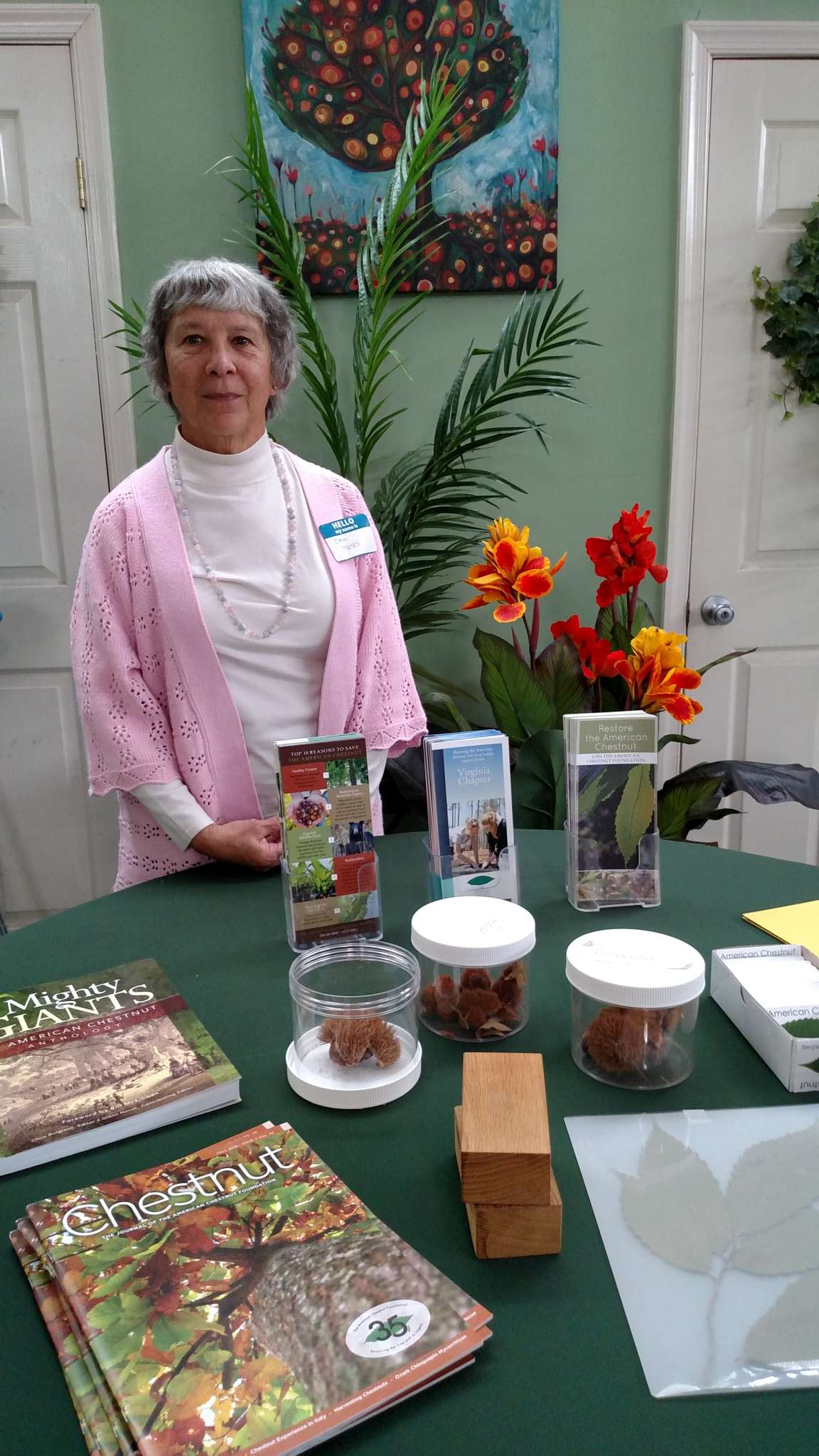Cathy Mayes made a presentation in January 2019 to the Prince William Area Council of Garden Clubs on chestnut trees and the blight that nearly obliterated the species in America. The Council membership is five garden clubs in Prince William County, Virginia.
Mayes Speaks to Prince William Garden Clubs
Virginia News Chapter Menu
National Facebook
One of the greatest ecological disasters the US has ever seen. Chestnut blight wiped out the American chestnut tree in less than 50 years.
A tree that once made up nearly 25% of the eastern forests was reduced to a functionally extinct species.
The Asian fungus Cryphonectria parasitica was accidentally introduced into the United States in the late 1800s. While a few diseased chestnuts were noted in the 1880s and 90s, it wasn't until 1904 that the pathogen was identified in New York City. From that point, the blight spread rapidly. By 1950 the entire range had been consumed.
The fungus causes cankers that spread around the trunk of the tree, girdling it and killing everything above ground. Many root systems still survive today and continue to send up shoots, but these also eventually succumb to blight. Because American chestnuts rarely survive long enough to reproduce, the species is considered functionally extinct.
The American Chestnut Foundation is working to develop blight-resistant American chestnuts that can be used to restore this iconic tree to its native range. Learn more at tacf.org/about-us (link in bio)
... See MoreSee Less
- likes love haha wow sad angry 1299
- Shares: 225
- Comments: 66
66 CommentsComment on Facebook
Incredibly important work…it was such a travesty for our forests!
It must've been an amazing sight to see all the trees when they were in bloom. I understand that some chestnuts were giants and comparable to sequoia. (That might have been an exaggeration...)
My neighbor has one that’s over 24” across and probably 70-80 years old
Just another day working to bring back the American chestnut. 🌰 ... See MoreSee Less
1 CommentComment on Facebook
I have a hybrid chestnut sapling that did good for a few years after planting. This year the leaves turned yellow, then brown, then completely fell off. Any ideas what could cause this? The tree appears to be alive still. Thanks.
Especially if you're under a canopy of American chestnuts... ... See MoreSee Less

6 CommentsComment on Facebook
Unless, of course, it's fall. Then the chestnut seed pods are falling from the trees and creating a floor covered in pins and needles so sharp that it puts sweetgum to shame. You wouldn't want to be laying under the chestnut canopy then!
I live in Barboursville, WV and wanted to know if i can buy a seedling or how i go about acquiring one! Thank you!
The SHADE TREE COMMISSION in NEW PALTZ New York is interested in planting some CHESTNUT trees on Chestnut Street (Rt. 32). We would like to receive help from you if possible. New Paltz is a historic town and in the past there were MANY Chestnut trees here, Presently there is only ONE Chestnut tree which I grew from the nut of an elegant, large tree when it was sadly cut down. If there are any Chestnut trees available, or if you have any suggestion that might help us in this quest we would be greatful. Thank you for your attention., Shelly Ottens (moc.oohay@obobnyllehsih)
Today was the last day of controlled pollinations in the southern region. Many thanks to the NC/SC Chapter members who came out to help! ... See MoreSee Less
8 CommentsComment on Facebook
Thank you for your hard work!
I'm in south Arkansas. We had miniature Chestnut call chink a pin which got wiped out in the 50s. I have found two this spring 2025. They are small.
Hello, is this a chestnut tree?
This summer, we’re aiming to produce 1,000 hand-pollinated nuts for our genomic-assisted breeding program, and each one is a vital step toward restoring the American chestnut.
Producing a single nut takes time, tools, and teamwork. From pollination to harvest, every step is a vital part of the process to ensure that each nut has the best chance possible to grow into a more blight-resistant tree.
Here’s what goes into a single $25 nut:
Pollination Bag: $5
Hand Pollination Process: $5
Harvesting the Nut: $5
Shucking & Storing: $5
Equipment & Fuel: $5
Total per Nut: $25
By supporting just one nut, you’re helping us bring the American chestnut back to our forests. Support a handful, and you’re helping to rebuild an entire ecosystem.
This nutty campaign only runs from June 3 to 23, and we’ve got 1,000 nuts to grow. Join us!
support.tacf.org/nuts
... See MoreSee Less
8 CommentsComment on Facebook
Would the Chestnut tree grow well in the upper Midwest?
Question, why don’t you just plant the seeds/trees in an orchard and let nature pollinate them? That would reduce the cost exponentially and sell the seeds by the bag full? So people can then plant them in mass? Also, Why only 1000 seeds when one tree can produce more than that?
Howdy. He have four American Chestnuts together, growing opposite of several Chinese. They are about 20 years old. An interesting study.

